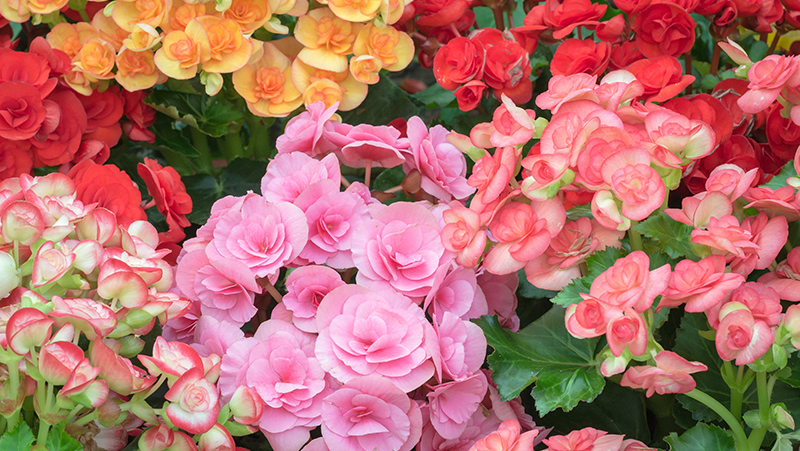Yates Account
Join now
Create a Yates account today!
Sign up to join the Yates Garden Club for monthly e-mails packed with seasonal inspiration, tips for success & exclusive promotions.
Plus if you’re a Garden Club member you can take part in the Yates Growing Community - a blog to share successes, get advice & win prizes in fun challenges along the way!

Forgot password
Enter the email address associated with your account, and we'll email you a new password.

How to grow Begonias in a garden
- Choose a position with well drained soil and full sun or part shade (depending on the variety - Check plant label first).
- Enrich the soil with Yates Dynamic Lifter Organic Plant Food. If the soil is clay based, add gypsum and fork in well.
- Dig the planting hole twice as wide and to the same depth as the root-ball. Remove the plant from the container and gently tease the roots.
- Position in hole and backfill, gently firming down. Form a raised ring around the plant, creating a well so that water will go where it’s needed most. Water in well.
- Mulch around the base with an organic mulch like woodchip or pea straw.
- Water deeply, once or twice a week, depending on weather conditions.
- Feed with Yates Thrive Rose & Flower Granular Plant Food . TIP: for an added boost apply Yates Thrive Fish Blood & Bone Plant Food Concentrate.

How to grow Begonias in a pot
- Choose a pot at least 200 mm wide (depending on the variety - Check plant label first).
- Position in full sun to part shade (depending on the variety - Check plant label first).
- Fill with quality potting mix, such as Yates Premium Potting Mix.
- Remove the plant from the container and gently tease the roots.
- Position in hole and backfill, gently firming down. Water in well.
- Water deeply, once or twice a week, depending on weather conditions.
- Feed with Yates Thrive Roses & Flowers Liquid Plant Food. TIP: for an added boost apply Yates Thrive Fish Blood & Bone Plant Food Concentrate.
Growing tips
- Begonias are easy to propagate from leaf or stem cuttings.
- Plants can also be grown from seeds. As they are quite fine, it is best to grow these in seed raising trays ensuring that they are lightly pressed into the mix and not covered. Water these well ensuring that they don’t dry out.
- If you are unsure whether your plant can handle full sun, check the leaves - Leaves that have a darker appearance prefer shade, whereas lighter coloured leaves tend to grow best in sunnier positions.
- Begonias prefer slightly acidic soil with a pH between 5.5 and 6.5. Using a pH test kit, check the soil pH prior planting out.
- If the soil pH is greater than 6.5, to lower the pH (acidify) apply Yates Soil Acidifier Liquid Sulfur.
- If the soil pH is lower than 5.5, to raise the soil pH (sweeten) apply Yates Hydrangea Pinking Liquid Lime & Dolomite. - Begonias can handle some periods of drought, but prefer to be well watered. Don’t be tempted to overwater these plants as they can rot if too much water is available or the soil is constantly saturated.
- There are many varieties of Begonias available. Some of these include:
Bedding/Shrub Begonias
This is the hardiest of all the varieties available. They can be grown in full sun to full shade and are low growing to create a bedding effect. This variety is often seen in public gardens, hanging baskets or streetscapes.
Cane Begonias
This variety has, as its name suggests, a cane like growth habit. These can grow quite tall with some being up to 2 metres in height! This variety is best grown in shade or semi- shade and kept away from afternoon sun.
Rhizomous Begonias
The most commonly known rhizomous Begonia is the 'Rex Begonia'. These are best grown in a sheltered shady environment and make a great indoor plant.
Tuberous Begonias (Begonia tuberhybrida)
Often difficult to grow, these Begonias have showy double flowers that come in a wide range of colours. They prefer a sheltered position in full to semi shade and are best grown in pots. Tubers are planted during winter and early spring for lovely flowers that appear from early Summer to late Autumn.
System.NullReferenceException: Object reference not set to an instance of an object. at Umbraco.Cms.Core.Models.PublishedContent.PublishedContentType..ctor(IContentTypeComposition contentType, IPublishedContentTypeFactory factory) at Our.Umbraco.DocTypeGridEditor.Helpers.DocTypeGridEditorHelper.<>c__DisplayClass15_0.<GetContentTypesByAlias>b__0() at Umbraco.Extensions.AppCacheExtensions.<>c__DisplayClass5_0`1.<GetCacheItem>b__0() at Umbraco.Cms.Core.Cache.SafeLazy.<>c__DisplayClass1_0.<GetSafeLazy>b__0() --- End of stack trace from previous location --- at Umbraco.Cms.Core.Cache.ObjectCacheAppCache.Get(String key, Func`1 factory, Nullable`1 timeout, Boolean isSliding, String[] dependentFiles) at Umbraco.Cms.Core.Cache.ObjectCacheAppCache.Get(String key, Func`1 factory) at Umbraco.Cms.Core.Cache.DeepCloneAppCache.Get(String key, Func`1 factory) at Umbraco.Extensions.AppCacheExtensions.GetCacheItem[T](IAppCache provider, String cacheKey, Func`1 getCacheItem) at Our.Umbraco.DocTypeGridEditor.Helpers.DocTypeGridEditorHelper.GetContentTypesByAlias(String contentTypeAlias) at Our.Umbraco.DocTypeGridEditor.Helpers.DocTypeGridEditorHelper.ConvertValue(String id, String contentTypeAlias, String dataJson) at Our.Umbraco.DocTypeGridEditor.Helpers.DocTypeGridEditorHelper.RenderDocTypeGridEditorItem(IViewComponentHelper helper, IHtmlHelper htmlHelper, Object model) at AspNetCoreGeneratedDocument.App_Plugins_DocTypeGridEditor_Render_DocTypeGridEditor.ExecuteAsync() at Microsoft.AspNetCore.Mvc.Razor.RazorView.RenderPageCoreAsync(IRazorPage page, ViewContext context) at Microsoft.AspNetCore.Mvc.Razor.RazorView.RenderPageAsync(IRazorPage page, ViewContext context, Boolean invokeViewStarts) at Microsoft.AspNetCore.Mvc.Razor.RazorView.RenderAsync(ViewContext context) at Microsoft.AspNetCore.Mvc.ViewFeatures.HtmlHelper.RenderPartialCoreAsync(String partialViewName, Object model, ViewDataDictionary viewData, TextWriter writer) at Microsoft.AspNetCore.Mvc.ViewFeatures.HtmlHelper.PartialAsync(String partialViewName, Object model, ViewDataDictionary viewData) at AspNetCore.Views_Partials_grid_editors_base.ExecuteAsync() in C:\home\site\wwwroot\Views\Partials\grid\editors\base.cshtml:line 23
















Share
Share this article on social media